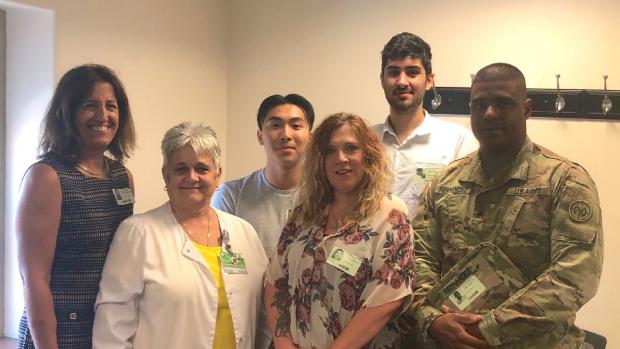Creating new technology to save lives
Alum Marisa Barbieri harnesses the power of AI and data to combat the opioid crisis

Alum Marisa Barbieri (left) and team members preventing and treating addiction with real-time data collection and analysis.
The National Institute on Drug Abuse reports that every day, more than 130 people in the United States die after overdosing on opioids — a class of drugs that includes heroin, synthetic opioids such as fentanyl, and prescription pain relievers such as oxycodone. In addition to that devastating human toll, the U.S. Centers for Disease Control and Prevention estimates that the total economic cost of prescription opioid misuse alone is more than $78 billion a year, which encompasses healthcare, lost productivity, addiction treatment, and criminal justice involvement.
Like almost a third of all Americans surveyed, alum Marisa Barbieri (’90) knew someone personally affected by the crisis — and as a computer scientist, adept at finding software solutions for difficult problems in the field of healthcare administration, she wondered how she could contribute to battling it.
Barbieri, who early in her career worked on IBM’s first AI tool, had made a move to the healthcare industry in the wake of her mother’s breast cancer diagnosis. “That was my first experience with what’s called a superbill — essentially a long itemized list of patient services containing complex codes that allow doctors to submit claims to insurance companies,” she said. “That’s when I realized the system was defective and that I might be able to help.” As a result, in 1997 Barbieri founded her own company, Competitive Solutions, focused on delivering healthcare solutions and services.
In early 2018, Barbieri — who was by then sitting on several healthcare-related boards — attended a meeting of the Data Informed Opioid Collaborative (DIOC), a group comprised of community teams and government officials (and now, at least one concerned techie) that is focused on preventing and treating addiction. Held in Fishkill, a small town in Upstate New York, the meeting regularly drew members of the New York National Guard Counter Drug Task Force, who explained to Barbieri that although they had a system in place to collect data on overdose cases, they needed help to scale it to the levels they envisioned.
Realizing that she could put her programming and AI skills to good use for the cause, Barbieri leaped into action, and soon the Hudson Valley Interlink Analytic System (HVIAS) was born.
Barbieri recalls how she saw her roll in this enterprise: “I wanted to contribute my company’s technology skills to develop a robust system that can help our communities save lives and develop outreach prevention, education and treatment intervention focused on actual data,” she said. Her goal was to expand upon the data collection tool the task force had been using, incorporating a technology she dubbed PreDX™, which provides not only data collection capabilities but also real-time SMS messages as overdose cases appear in hospital emergency rooms or local clinics.
Such information alerts first responders when a “cluster” of cases seems to be forming in a particular locale. This allows them to assemble needed kits of overdose-reversal medication and gives community outreach workers and peer counselors critical forewarning so that they can focus on the areas that are being hit the hardest.
Many hospitals are signing up to get HVIAS in New York and plans are to gradually roll it out across the entire state and the nation.
Barbieri, who is making the platform available free of charge through her 1Life Project initiative, intends to build a National Opioid Data Center, continually updated with real-time information and analysis. “Besides increasing the timeliness of reporting both nonfatal and fatal opioid overdoses through emergency department and emergency medical services data, we’re offering the first-ever reporting of other risk factors and social determinants of health that may be associated with overdoses,” she explained. “We believe that decision makers need information they can use — not just data that can be overwhelming or misunderstood.”
Barbieri, who sits on the board of Tandon’s Polytechnic Alumni Association, developed HVIAS with the help of a team that included another NYU alum, James Kong (’19), as well as a current Tandon student, Karam Lyons. “The School of Engineering has long stressed the need to develop technology that will solve pressing social needs,” she said. “I’m happy to have adopted that ethos and grateful that new generations of students are doing the same.”




